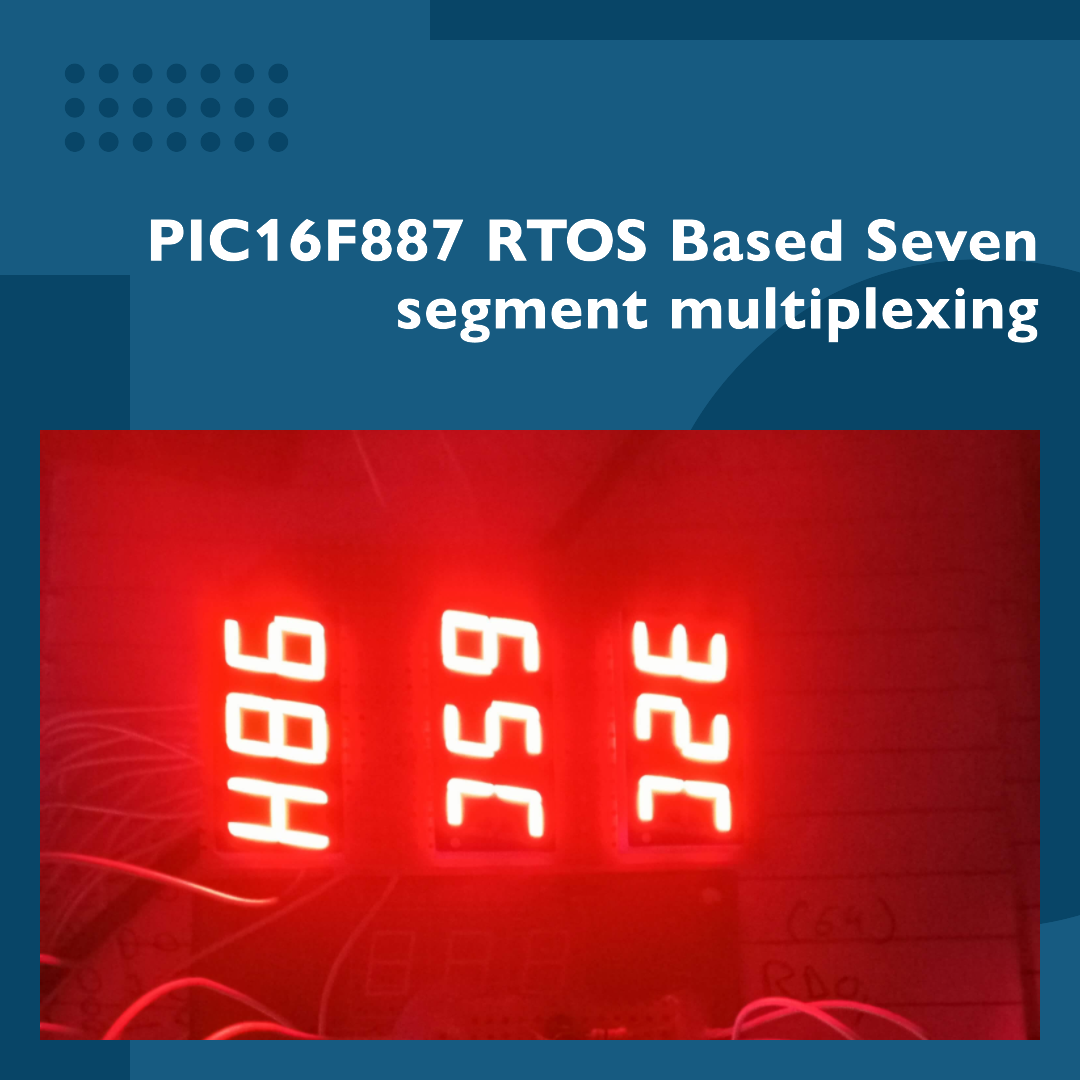Multiplexing 7 segment display is one of major problem. We try to solve this problem using RTOS in PIC CCS Compiler. In this blog post we demonstrated 9-digit seven segment multiplexing using PIC16F887 microcontroller.
Table of Contents
Required Components
Here are the list of required components for driving 7 segment display with PIC16F887 microcontroller.
- PIC16F887 Microcontroller
- Seven-Segment Display (Common Anode, 9 Digits)
- A733 NPN Transistors (9 units)
- 1KΩ Resistors (9 units for base resistors of A733 transistors)
- 10KΩ Resistors (9 units for base to emitter resistors of A733 transistors)
- 7805 Voltage Regulator
- Crystal Oscillator (e.g., 8MHz)
- 22pF Capacitors (2 units for crystal oscillator)
- Current Limiting Resistors (for each segment of each digit)
- Power Supply (providing appropriate voltage and current for the microcontroller and display)
- Decoupling Capacitors (e.g., 100nF)
- Breadboard or PCB
- Jumper Wires
- PIC Programmer (e.g., PICkit)
- Pull-up or Pull-down Resistors (if required for input pins)
- External Components (such as buttons, sensors, etc., if needed for input)

Wiring Instructions
- Connect PIC16F887 pins to Seven-Segment Display:
- Connect PIC pins to display segments via current-limiting resistors.
- Connect common anode pins of each digit to A733 transistors’ collectors.
- A733 Transistor Connections:
- Connect A733 transistors’ emitters to ground.
- Connect A733 transistors’ bases to PIC pins via 1KΩ resistors.
- Connect A733 transistors’ collectors to common anode pins of display digits.
- Power Supply and Voltage Regulator:
- Connect power supply positive to 7805 voltage regulator input.
- Connect voltage regulator output to PIC Vcc and display common anode pins.
- Connect voltage regulator ground to circuit ground.
- Crystal Oscillator and PIC Oscillator Pins:
- Connect crystal oscillator pins to PIC OSC1 and OSC2 pins.
- Add 22pF capacitors between OSC1 and ground, and OSC2 and ground.
- Decoupling and Stability:
- Add 100nF decoupling capacitors close to PIC Vcc and ground pins.
- Input Components (if used):
- Connect input components (buttons, sensors) to PIC pins.
- Use pull-up/down resistors if required for input stability.
- PIC Programmer:
- Connect PIC programmer to PIC programming pins for programming and debugging.
- Grounding:
- Connect all ground (GND) points in the circuit together for a common ground reference.
PIC CCS 7 segment multiplexing Code
Here is the complete working code for the RTOS based 7 segments multiplexing 9 digits.
#include <16F887.h>
#fuses NOMCLR, NOBROWNOUT, NOLVP, INTRC_IO
#use delay(clock = 4MHz)
#use fast_io(B)
#use fast_io(C)
#use fast_io(D)
#use rtos(timer = 0, minor_cycle = 50ms)
// Constants and pin definitions
#define NUM_DIGITS 9
unsigned char seg_code[] = {0x03, 0x9F, 0x25, 0x0D, 0x99, 0x49, 0x41, 0x1F, 0x01, 0x09, 0xFF, 0x63, 0x91};
int disp_pins[] = {PIN_C0, PIN_C1, PIN_C2, PIN_C3, PIN_D0, PIN_D1, PIN_D2, PIN_D3, PIN_C4};
unsigned char allDigits[] = {11, 2, 3, 11, 5, 6, 12, 8, 9};
// Global variables
char digitsArray[6]; // Array to store digits between 0 and 9
// Function prototypes
void multiplex();
void mdelay();
#task(rate = 50ms, max = 50ms)
void mdelayTask() {
while (1) {
mdelay(); // Call the mdelay function for multiplexing
}
}
void main() {
setup_oscillator(OSC_4MHZ); //internal oscillator setup
output_b(0); // All PORTB register pins are zeros
set_tris_b(0); // Configure PORTB pins as outputs
set_tris_c(0xFF); // Configure PORTC pins as inputs
set_tris_d(0xFF); // Configure PORTD pins as inputs
rtos_run(); // Start all the RTOS tasks
}
void multiplex() {
for (int i = 0; i < NUM_DIGITS; i++) {
output_b(seg_code[allDigits[i]]);
output_low(disp_pins[i]);
delay_ms(1);
output_high(disp_pins[i]);
}
}
void mdelay() {
int i = 0;
for (i = 0; i < 13; i++) {
multiplex();
delay_ms(5);
}
}
Code language: PHP (php)